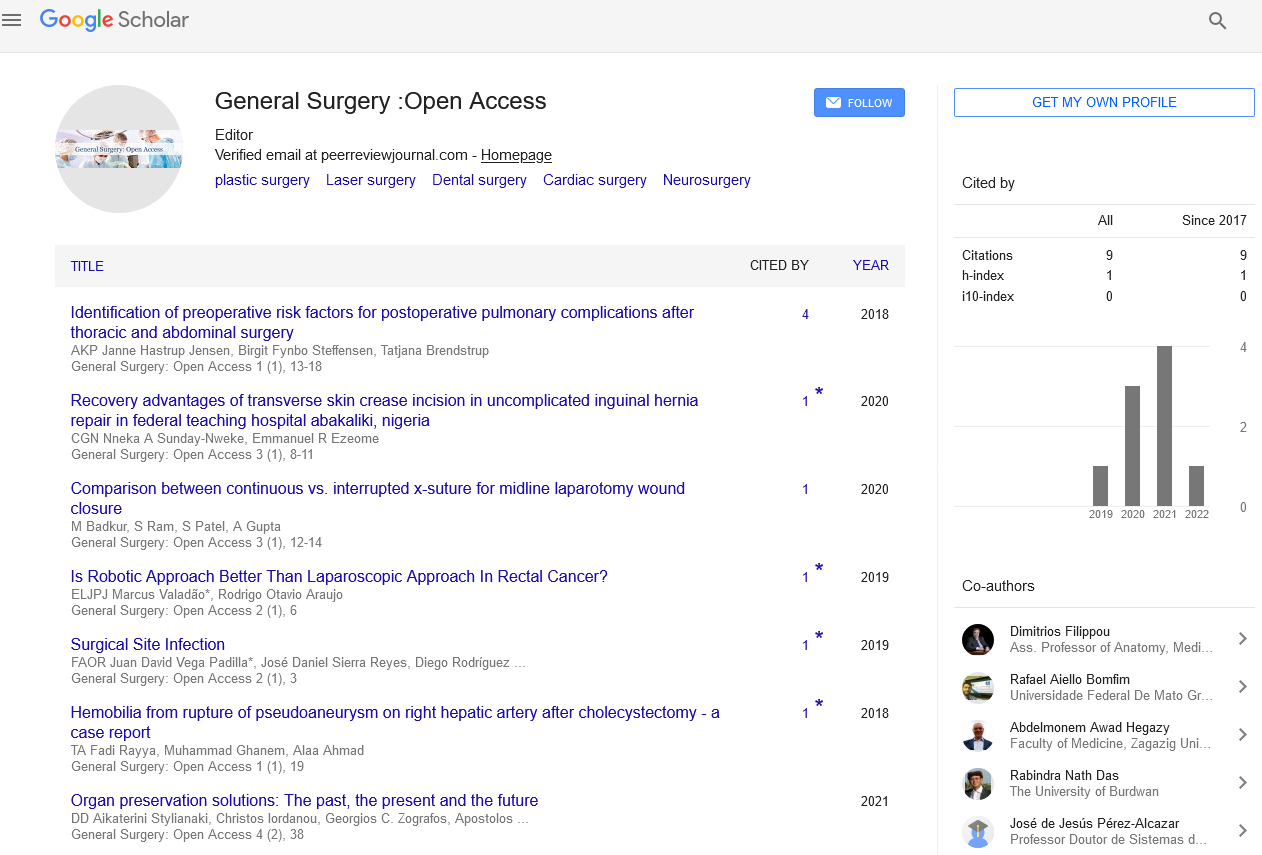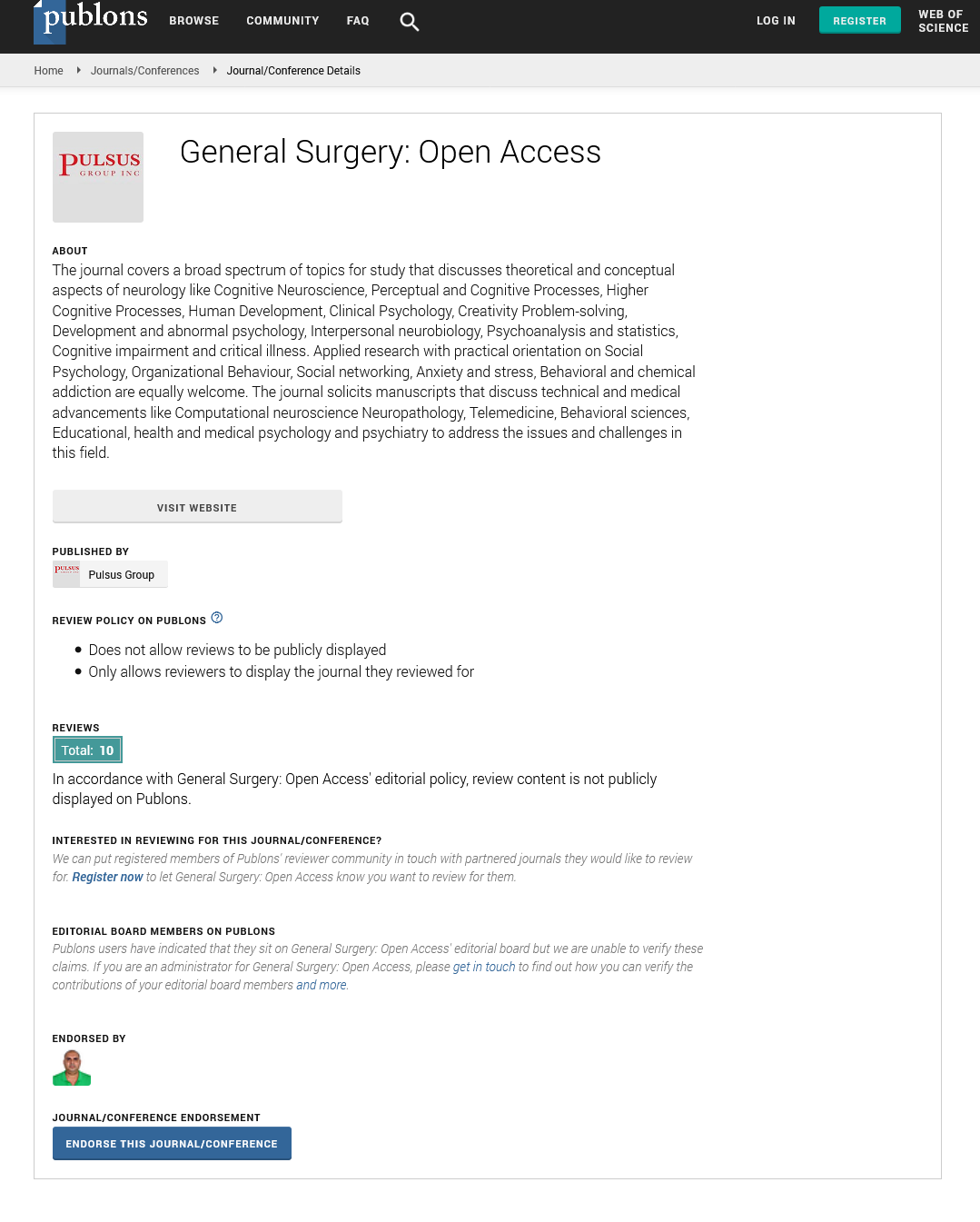Minimally invasive gastrointestinal surgery
Received: 02-Mar-2021 Accepted Date: Mar 18, 2021; Published: 25-Mar-2021
Citation: Swart M. Minimally invasive gastrointestinal surgery. Gen Surg: Open Access. 2021;4(2):9.
This open-access article is distributed under the terms of the Creative Commons Attribution Non-Commercial License (CC BY-NC) (http://creativecommons.org/licenses/by-nc/4.0/), which permits reuse, distribution and reproduction of the article, provided that the original work is properly cited and the reuse is restricted to noncommercial purposes. For commercial reuse, contact reprints@pulsus.com
Description
For most patients who need gastrointestinal medical procedure, a negligibly intrusive methodology is desirable over a conventional open strategy, which may require a long entry point from sternum to navel. These less-obtrusive medical procedures, like laparoscopy, include little entry points, cause less agony and take into consideration quicker recuperation. Patients return home from the clinic sooner, have less complexity like diseases, hernias, and grips and have less scarring all around.
Minimally invasive surgery is additionally the favored strategy for bariatric weight reduction medical procedures, and for medical procedure to treat kind colorectal illness and malignancy. An insignificantly obtrusive gastrointestinal medical procedure commonly utilizes fiber optics and a superior quality camcorder to project the careful field onto a screen in the working room. With the patient under broad sedation, the specialist makes a few little cuts in the mid-region to put little ports or cylinders that will oblige the apparatuses required for the activity. Through one port, the specialist siphons carbon dioxide into the stomach hole, making a workspace, and afterward embeds the videoscope, which sends pictures to a huge top notch screen. When the specialist finishes the technique, the person eliminates the ports and permits the carbon dioxide to get away from the pit. Any gas that remains will be consumed by the body and ousted through breath.
Minimally invasive gastrointestinal surgeries are just about as compelling as traditional open medical procedures, and can, at times, have shockingly better results. While open medical procedures regularly require an in-emergency clinic recuperation time of five to 10 days, insignificantly obtrusive medical procedure makes considerably less injury sound tissue, reducing patients' torment and speeding up their recuperation. Insignificantly obtrusive medical procedure likewise radically decreases the dangers of wound entanglements, including diseases, hernias and scar tissue development.
Types of minimally invasive surgery
Robotic surgery: Advanced automated frameworks give specialists more prominent control and vision during medical procedure, permitting them to perform protected, less intrusive, and exact surgeries. During automated helped a medical procedure, specialists work from a comfort furnished with two expert regulators that move four mechanical arms. By review a top notch 3-D picture on the support, the specialist can see the surgery like nothing anyone's ever seen previously. PC programming replaces genuine hand developments and can make developments exact.
Non-robotic minimally invasive surgery: Non-automated negligibly intrusive medical procedure is otherwise called endoscopic medical procedure. You likewise might be acquainted with terms like laparoscopic medical procedure, thoracoscopic medical procedure, or "keyhole" medical procedure. These are insignificantly intrusive systems that use an endoscope to arrive at inward organs through little cuts. During endoscopic medical procedure the specialist embeds a meager, adaptable cylinder with a camcorder through a little cut or characteristic openings like the mouth or nostrils. The cylinder has a channel to use minuscule careful instruments, which the specialist utilizes while seeing the organs on a PC screen. This method permits the specialist to see inside the patient's body and work through a lot more modest entry point than would somehow or another be expected of customary open a medical procedure. Minimally invasive surgery (MIS) for upper gastrointestinal (GI) disease, described by minimal access, has been progressively performed around the world. It brings about better restorative results, yet additionally lessens intraoperative blood misfortune and postoperative torment, prompting quicker recuperation; nonetheless, endoscopically upgraded life structures and improved hemostasis through sure intracorporeal pressure created by CO2 insufflation have not added to decrease in early postoperative difficulties or improvement in long haul results. Since 1995, we have been effectively utilizing MIS for operable patients with resectable upper GI disease and have created steady and hearty philosophy in directing absolutely laparoscopic gastrectomy for cutting edge gastric malignant growth and inclined thoracoscopic esophagectomy for esophageal disease utilizing novel innovation including Da Vinci Surgical System (DVSS). We have as of late showed that utilization of DVSS may lessen postoperative nearby confusions including pancreatic fistula after gastrectomy and repetitive laryngeal nerve paralysis after esophagectomy. In this article, we present the current status and future viewpoints on MIS for gastric and esophageal malignancy dependent on our experience and a survey of the writing.






